hankyoreh
Links to other country sites 다른 나라 사이트 링크
[Korea travels] Tongyeong: Come for the cherry blossoms, stay for the art festivals
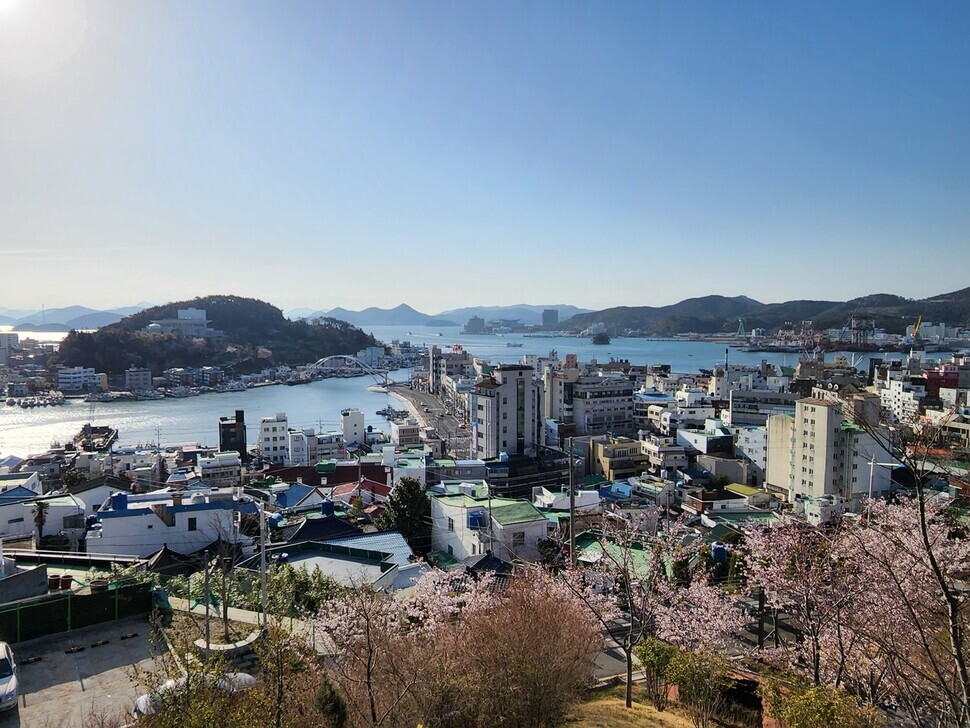
With a population of just over 120,000, Tongyeong is a port city and city of art located in South Gyeongsang Province.
It is famous for having produced such renowned artists as the novelist Pak Kyong-ni, the composer Yun I-sang, the poet Kim Chun-su, and the painter Jeon Hyuck-lim. It’s also the setting for various art festivals, including the Tongyeong Theatre Arts Festival and Tongyeong Art Festival — as well as the Tongyeong International Music Festival, considered one of the top three music festivals in Asia.
With the cherry blossoms in full bloom, the Tongyeong spring was replete with the fragrance of art. On March 31, I paid a visit to the city’s Donam neighborhood, where the inaugural Tongyeong Triennale — an international event that takes place every three years — was underway. (The event continues until May 8.)
Adopting the theme of “Tongyeong: The sea, the seeds,” the festival features works from various genres, including fine art, ceramics, photography, and media art.
Events were taking place throughout the mainland and island regions of Tongyeong: the special craft exhibition “Hands to Art” at the Tongyeong City Museum, the feature exhibition “Kim Sung-soo’s Korean Ottchil Art History” at the Ottchil Art Museum and the island-associated exhibition “Double Oceans” on Hansan Island. While the festivities are going on, the whole city of Tongyeong becomes one big museum of culture and art.
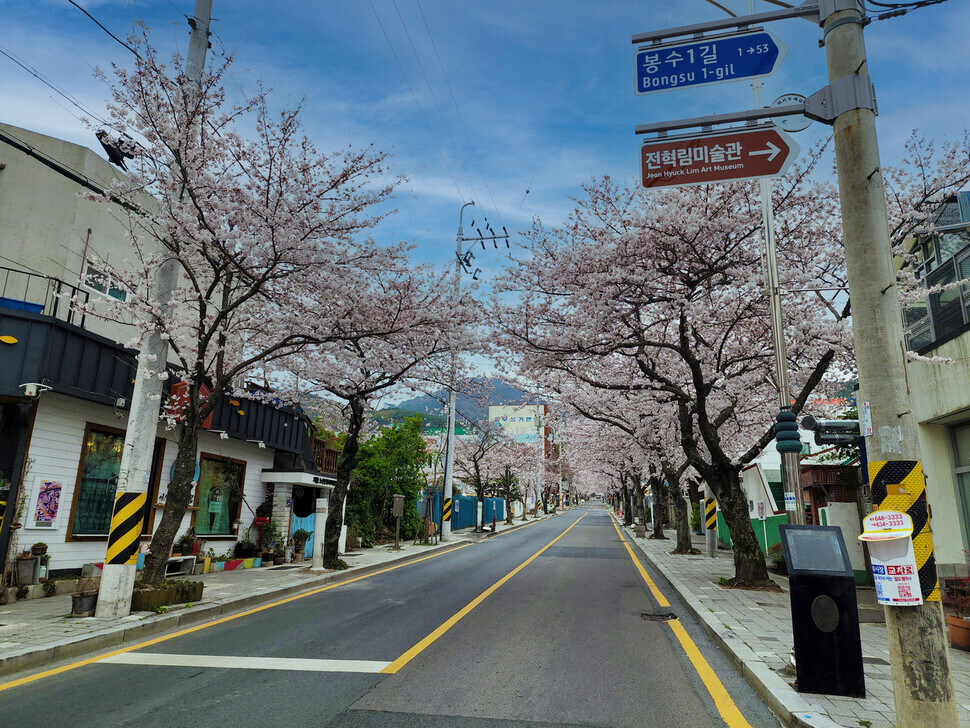
The venue for the Tongyeong Triennale themed exhibition “TAKE YOUR TIME” is a former research building for the Shina SB shipyard. In this case, the meaning of “take your time” is to “take the past to create the present and design the future.”
Thirty-eight artists from 13 countries are taking part with works from genres including painting, sculpture, installation, film and photography. In one setting, visitors can see everything from 19th-century painting work by the French artist Edouard Athenosy to “Soul in Its Later Years” by mother-of-pearl master Kim Jong-ryang and the latest in artificial intelligence (AI) art.
Situated at the building’s staircase is work that presents the shapes of water through video art. This work, titled “Elevation,” was co-created by the Tongyeong Triennale’s international commissioner and co-curator Daniel Kapelian with the Buddhist monk Hyon Gak.
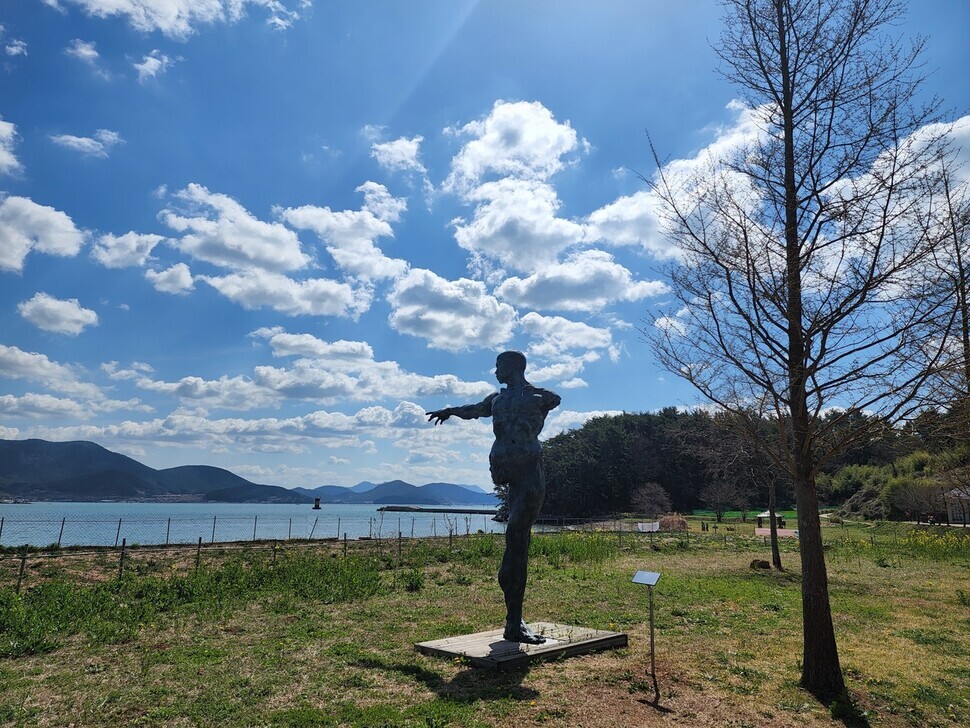
Fellow Tongyeong Triennale co-curator Cho Hye-young said, “We made the themed exhibition space like a black box so that the viewers could focus on the artwork on display.”
“We created a path of meditation toward achieving enlightenment as visitors climb the stairs rather than taking an elevator between floors,” she added, explaining that the experience was designed as an opportunity for people to take out from their busy lives and look within themselves through art.
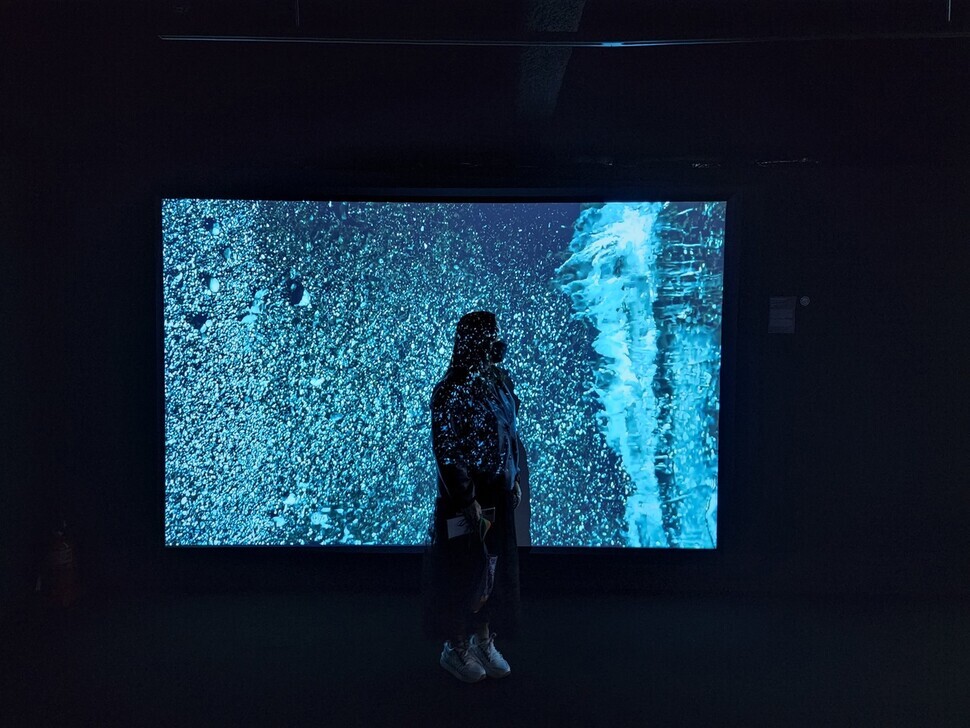
In a warehouse building next to the themed exhibition was “Weaving Islands,” an exhibition spotlighting the work of young artists. In this space are island-themed works produced by 14 young artists/artist teams who took part in a residency on Tongyeong’s islands.
They include photographs and films of the islanders and artwork made from Styrofoam picked up off the island. This exhibition is a place where visitors can glimpse islander lives as seen from the perspectives of the different artists.
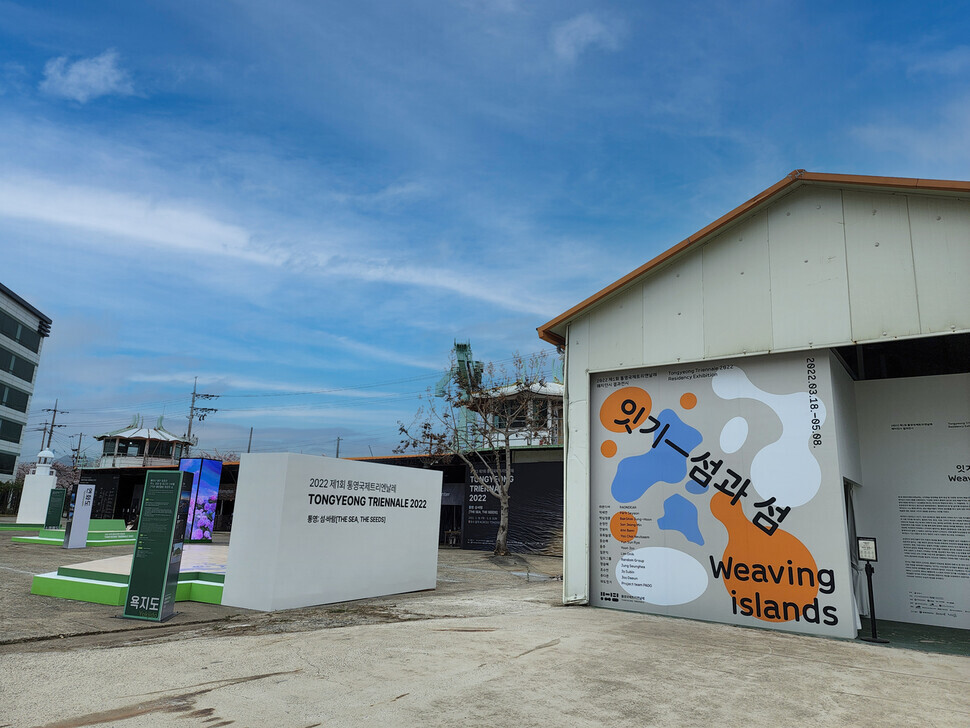
A special exhibition on the work of Jeon Hyuck-lim is taking place at the Jeon Hyuck Lim Museum of Art on Bongsu Road, a street renowned as Tongyeong’s premier cherry blossom road.
Jeon Hyuck-lim has been referred to as a “magician of color” for his work boasting unique colors and landscapes, including “Swamp” and “Tongyeong Port.” With the theme “The Eternal Color of the Sea,” Jeon’s exhibition is a special Tongyeong Triennale exhibition event where visitors can see the work and artistic vision of the late artist, who captured the sea and skies of Tongyeong in his images.
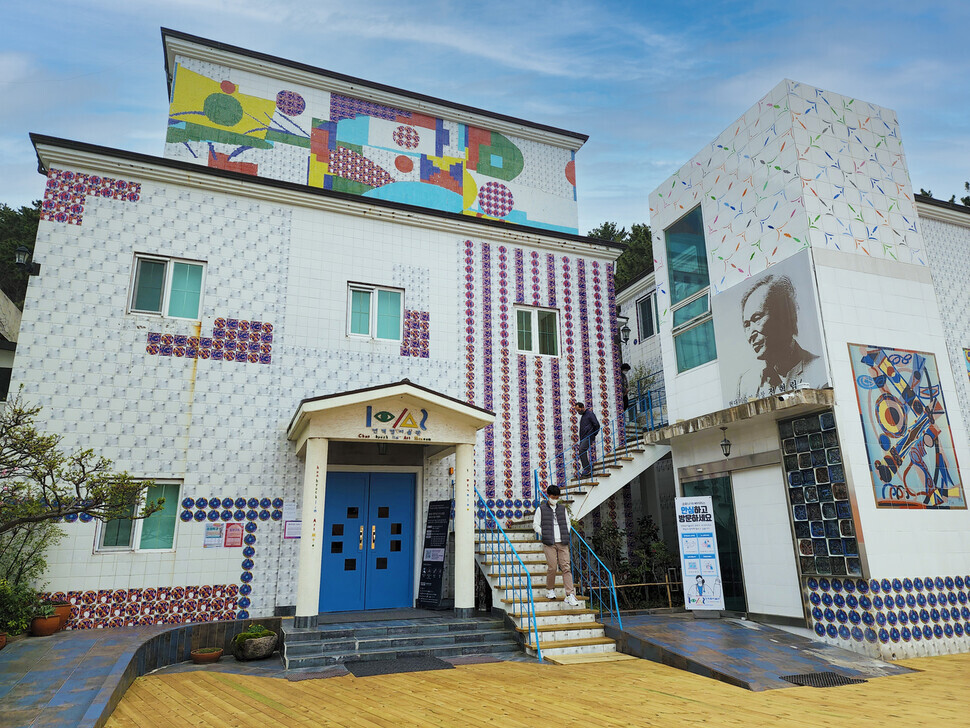
Featured in the Jeon Hyuck Lim Museum of Art’s first-floor gallery is the exhibition “Picasso and Jeon Hyuck Lim.” There, Jeon’s works “Mandala” and “From Folk Art,” along with three other smaller oil works, are on display next to four works by Pablo Picasso — including “Flying Dove with a Rainbow” — and three posters from Picasso’s exhibitions.
The Jeon Hyuck-lim special exhibition can be viewed free of charge between 10 am and 6 pm every day except for Mondays (when the museum is closed) until the Triennale ends on May 8.

Located in the Tongyeong neighborhoods of Myeongjeong and Seoho, the Seopirang area hosted side street exhibitions featuring works of Korean lacquer painting known as ottchil and printmaking by local artists. This locally focused event was organized by the Tongyeong Triennale.
With a name meaning “western cliffs,” Seopirang faces another village called Dongpirang (“eastern cliffs”), which is renowned for its murals. After Korea’s liberation in 1945, Seopirang became the setting for a red-light district that eventually disappeared in the 2000s.
It was in 2013 that winds of change arrived in what was then a decaying neighborhood. After a movement organized by residents to transform it into a new community, it now sits alongside Dongpirang as one of the region’s premier tourism destinations.
Seopirang is also the focus of literary pilgrimages. In addition to being the birthplace of novelist Pak Kyong-ri, it also provides the setting for her work “The Daughters of Pharmacist Kim.”
The village further boasts the 99 Stairs, sometimes referred to as the “Pak Kyong-ni stairs.”
Poetry and quotes by Pak herself are emblazoned on the staircase walls: “The lives of all living things are beautiful.” “During that time, the only thing watching over me in my old house was silence.” “Nature is a teacher that enriches character and nurtures emotions.”
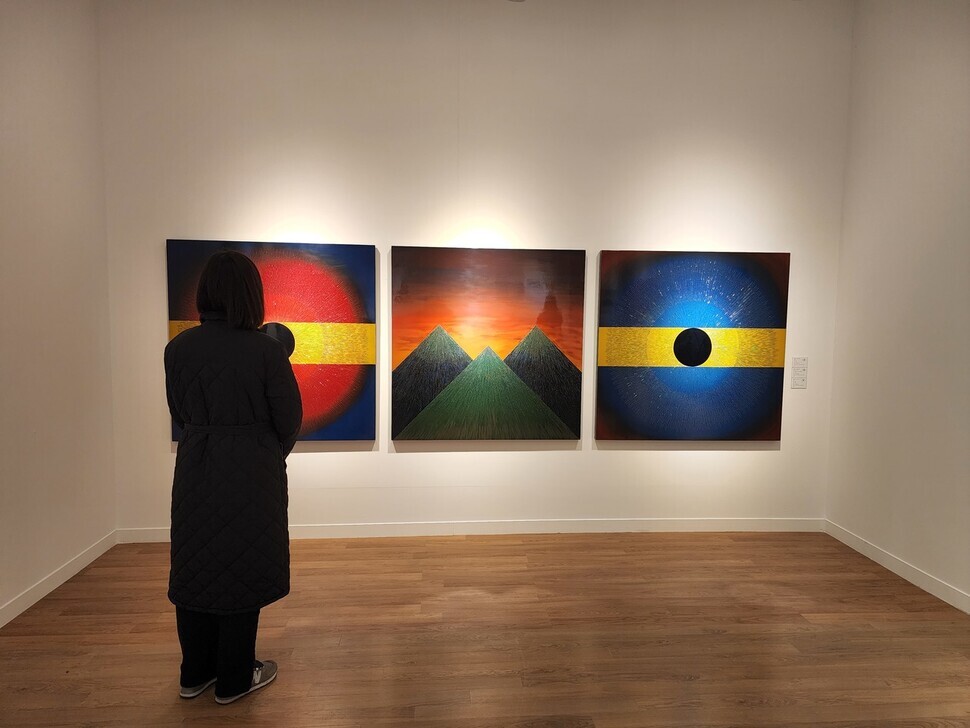
Traveling up the 99 Stairs, you come to the pavilion of Seoporu and a small park. This setting offers a view of Dongpirang across the way, along with the old naval headquarters of Tongjeyeong, the pavilion of Bukporu, and the placid waters of the southern sea.
This setting is famous among shutterbugs as a top photography site in Tongyeong. Those who make the climb can see the Tongyeong that Pak wrote about in her book “The Daughters of Pharmacist Kim,” as quoted on the staircase wall:
“Tongyeong is a humble fishing port located near an archipelago. Situated midway along the sea route between Busan and Yeosu, it is referred to by the young people there as the ‘Korean Naples’ — so bright and blue are the sea’s colors.”

Tongyeong’s islands, including Hansan and Saryang, also are included among the settings of the art festival.
Hansan Island, located in Tongyeong’s southeast, features an exhibition on the theme “Double Oceans,” which includes a media art piece based on the “War Diary” of Admiral Yi Sun-sin. The exhibition venue has been set up in the Jeseungdang shrine’s management office (rest area).
Hansan Island is a historic site, having been the setting of the Battle of Hansan Island — one of three major victories during the Imjin War in 1592. It was also the headquarters for the navies of three provinces (Gyeongsang, Jeolla, and Chungcheong) commanded by Admiral Yi. Indeed, the name “Tongyeong” comes from the word used to refer to those headquarters.
Those wanting to visit the former headquarters at Jeseungdang can catch a Hansan Jeseungdang ferry at the Tongyeong Ferry Terminal. Boat service is available hourly between 7 am and 6 pm. The trip takes about 25 minutes. From the dock, it’s a 1-kilometer trip along the coast to Jeseungdang.
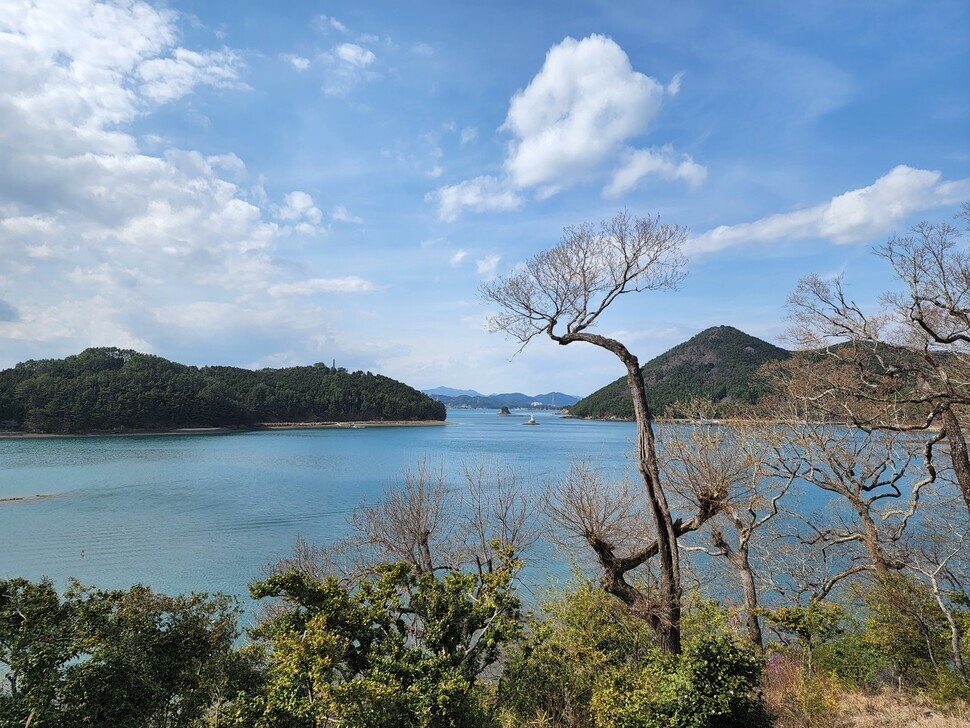
This walking route is an opportunity to see the island’s dense pine forest, which boasts a broad habitat of red pines. Hansan Island’s red pines were said to have been used to make turtle ships (geobukseon) and board-roofed ships (panokseon) during the Imjin War.
A roughly 30-minute walk along the coast brings you to Jeseungdang. With a name meaning “the hall for making victory,” it furnished Yi with his office and the setting where he devised his operations. This place is said to be where Yi spent 1,029 of the 1,491 days recorded in his war diary.
At the entrance to Jeseungdang, you can see the Suru watchtower to your right. The signboard there shows a poem once recited by Yi. Here, too, visitors can see the sprawling sea off Hansan Island.
For those who would like to learn about Hansan Island in greater depth, I recommend walking along Bada Baengni Road — meaning “100 ri by the sea” — which travels through the island.
This course, which travels from Deopeuldae to Mangsan Mountain (293.5 meters) and Jindu (12 km, four hours), was created as a path for the A-frame carriers (jige) used by islanders to carry wood into the hills. It’s an opportunity to visit both the hills and the sea of an island that is rich with the scents of spring.
By Her Yun-hee, staff reporter
Please direct questions or comments to [english@hani.co.kr]

Editorial・opinion
![[Editorial] Intensifying US-China rivalry means Seoul must address uncertainty with Beijing sooner than later [Editorial] Intensifying US-China rivalry means Seoul must address uncertainty with Beijing sooner than later](https://flexible.img.hani.co.kr/flexible/normal/500/300/imgdb/original/2024/0517/8117159322045222.jpg) [Editorial] Intensifying US-China rivalry means Seoul must address uncertainty with Beijing sooner than later
[Editorial] Intensifying US-China rivalry means Seoul must address uncertainty with Beijing sooner than later![[Column] When ‘fairness’ means hate and violence [Column] When ‘fairness’ means hate and violence](https://flexible.img.hani.co.kr/flexible/normal/500/300/imgdb/original/2024/0516/7417158465908824.jpg) [Column] When ‘fairness’ means hate and violence
[Column] When ‘fairness’ means hate and violence- [Editorial] Yoon must stop abusing authority to shield himself from investigation
- [Column] US troop withdrawal from Korea could be the Acheson Line all over
- [Column] How to win back readers who’ve turned to YouTube for news
- [Column] Welcome to the president’s pity party
- [Editorial] Korea must respond firmly to Japan’s attempt to usurp Line
- [Editorial] Transfers of prosecutors investigating Korea’s first lady send chilling message
- [Column] Will Seoul’s ties with Moscow really recover on their own?
- [Column] Samsung’s ‘lost decade’ and Lee Jae-yong’s mismatched chopsticks
Most viewed articles
- 1For new generation of Chinese artists, discontent is disobedience
- 2[Editorial] Transfers of prosecutors investigating Korea’s first lady send chilling message
- 3[Exclusive] Unearthed memo suggests Gwangju Uprising missing may have been cremated
- 4[Editorial] Intensifying US-China rivalry means Seoul must address uncertainty with Beijing sooner t
- 5S. Korea “monitoring developments” after report of secret Chinese police station in Seoul
- 6N. Korean media upgrades epithet for leader’s daughter from “beloved” to “respected”
- 7Yoon says concern about biased diplomacy is being incited by “communist totalitarian forces”
- 8[Column] US troop withdrawal from Korea could be the Acheson Line all over
- 9Xi, Putin ‘oppose acts of military intimidation’ against N. Korea by US in joint statement
- 1060% of young Koreans see no need to have kids after marriage